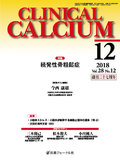Japanese
English
- 有料閲覧
- Abstract 文献概要
- 1ページ目 Look Inside
- 参考文献 Reference
ステロイド過剰症は続発性骨粗鬆症をきたす代表的疾患として確立されており,疾患関連続発性骨粗鬆症としてのクッシング症候群による内因性グルココルチコイド(GC)過剰と,治療関連続発性骨粗鬆症としてのGC服用がこれに該当する。クッシング症候群のみならず頻度の高いサブクリニカルクッシング症候群も骨折リスクが高まるとされ,骨粗鬆症診断時には常に念頭に置く必要がある。薬剤性のステロイド性骨粗鬆症はGC投与後早期から骨密度低下,骨折リスク上昇をきたすことから投与開始時から管理を要する。ステロイド性骨粗鬆症の管理と治療ガイドライン2014年改訂版は,スコア法を用いた臨床使用が容易なガイドラインとなっており,広く使用されることが望まれる。
Glucocorticoid(GC)excess is one of the most common causes of secondary osteoporosis, which can be associated with a disease(GC excess due to Cushing's syndrome)or with a treatment(GC medications). In addition to Cushing's syndrome, subclinical Cushing's syndrome, which occurs more frequently, can also increase the risk of fractures. Thus, it is important to consider these diseases when making the diagnosis for osteoporosis. GC-induced osteoporosis leads to reduction of bone mineral density and increased risk of fracture from the early stage after initiation of GC treatment, and thus requires management from the time of initiation. The 2014 revised Guidelines on the Management and Treatment of GC-induced Osteoporosis should be used routinely in the clinical settings as they introduce a scoring system that is easily adoptable.



